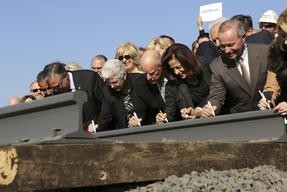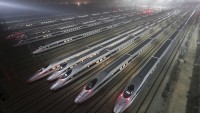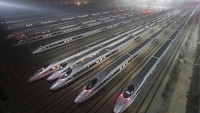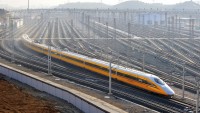Will California's Bullet Train Fly?
| Jose Mario Fuderanan | | Jan 07, 2015 06:59 PM EST |
(Photo : Reuters) Groundbreaking ceremony for bullet train in Fresno, California.
It has been Gov. Jerry Brown's dream to have a high speed rail in California since he first took office three decades ago. With Tuesday's groundbreaking ceremonies in Fresno, the mega-project is finally on track.
The US$68 billion bullet train system will run for 520 miles through the Central Valley, linking San Francisco's downtown Transbay Terminal to the Union Station in Los Angeles. The trains will have a top speed of 200 mph and tickets will cost from US$81 to US$89 for a three-hour or less trip.
Like Us on Facebook
The first passenger train will be servicing the route by 2029, if all goes well.
The project was slow to come on track even after the 2008 vote by Californians authorizing the US$9 billion rail bonds which would jumpstart the program. It has been hounded by setbacks for years, including lawsuits, politicking and future funding.
Brown called the naysayers "weak of spirit" saying "everything big runs into opposition.
"We've been talking about this 35 years, and they tell me we've still got 15 to go. Well, I'm going to try to cut a few corners here and get it going," Brown said.
Dick Ettington, a retired railroad executive from Palos Verdes Peninsula, wrote to The Los Angeles Times that the San Francisco-L.A. rail was doomed to fail because of the notable absence of freight between the two cities.
He said that "rail was only ideal for passengers when there were plenty of freight trains to help pay for it." He added that taxpayers will have to cover the cost of building the system for many years.
Brown had revised the estimated project cost to US$100 billion but settled for $68 billion after heavy opposition. In 2012, lawmakers had dropped US$5.8 billion in the hat to start construction.
Last year, a quarter of future revenues from California's carbon-reduction program had been pledged to help fund the project in future years.
According to California's High-Speed Rail Authority, the $68 billion is still much cheaper than constructing countless miles of highways and airport runways to accommodate an estimated 46 million Californians by the year 2035.
TagsJerry Brown, california, fresno, dick ettington, high-speed rail, bullet train
©2015 Chinatopix All rights reserved. Do not reproduce without permission
EDITOR'S PICKS
-

Did the Trump administration just announce plans for a trade war with ‘hostile’ China and Russia?
-

US Senate passes Taiwan travel bill slammed by China
-

As Yan Sihong’s family grieves, here are other Chinese students who went missing abroad. Some have never been found
-

Beijing blasts Western critics who ‘smear China’ with the term sharp power
-

China Envoy Seeks to Defuse Tensions With U.S. as a Trade War Brews
-

Singapore's Deputy PM Provides Bitcoin Vote of Confidence Amid China's Blanket Bans
-

China warns investors over risks in overseas virtual currency trading
-

Chinese government most trustworthy: survey
-

Kashima Antlers On Course For Back-To-Back Titles
MOST POPULAR
LATEST NEWS
Zhou Yongkang: China's Former Security Chief Sentenced to Life in Prison

China's former Chief of the Ministry of Public Security, Zhou Yongkang, has been given a life sentence after he was found guilty of abusing his office, bribery and deliberately ... Full Article
TRENDING STORY

China Pork Prices Expected to Stabilize As The Supplies Recover

Elephone P9000 Smartphone is now on Sale on Amazon India

There's a Big Chance Cliffhangers Won't Still Be Resolved When Grey's Anatomy Season 13 Returns

Supreme Court Ruled on Samsung vs Apple Dispute for Patent Infringement

Microsoft Surface Pro 5 Rumors and Release Date: What is the Latest?














